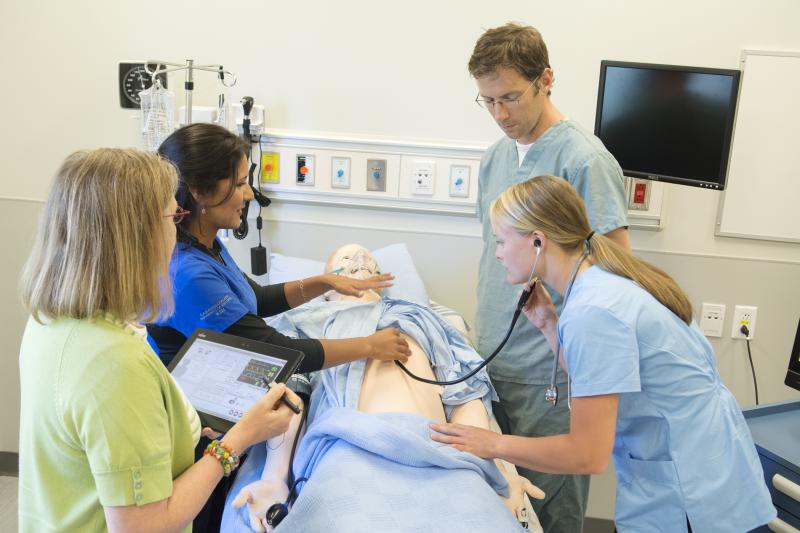By Maureen M. Ryan RN, BN, MN, PhD
The practice of ‘patient simulation’ in health care and nursing education has gone beyond the practicalities of how to create a simulation centre and has progressed to evaluation of teaching practices and scholarship. If we turn to the literature, we discover that many users of simulation technology are critically evaluating teaching and learning theory(s) merging that body of knowledge with the practices of delivering simulated practice education.
Teaching clinical skill in preparation for today’s health care system is not an easy task. We believe this can be improved by the purposeful use of and evaluation of simulation technology. We cannot put students in a room with a high-fidelity mannequin and expect competency unless the experience is structured and deliberate. Research in teaching and learning practices ought to occur if we are to take advantage of these simulation experiences.
On behalf of my colleagues and I, we thank you for allowing us to provide an overview of some of the ongoing research activities in simulation education for pre-licensure nursing and inter-professional patient care teams.
“Developing the GITCS (Global Interprofessional Therapeutic Communication Scale): A pilot study in BC” (2016‐ 2017)
PI: Suzanne Campbell (UBC Nursing) Co‐investigators: Bontinen, K (Douglas College); duManoir, C (UBCO); Haley, A (UFV); Jackson, L (UFV); Kirk, L (Douglas College); Lim, X (UBC); Marcellus, L (UVic); Murdoch, N (UBCO); Ryan, M (UVic); Wong, S (BCIT). UBC Medicine $7500.
The purpose of this study is to engage nurse educators familiar with simulation pedagogy in the development of an interprofessional health communication tool that can be used to evaluate health professional students’ progress in developing therapeutic communication skills in patient simulation learning events.
“Instilling simulation pedagogy through the BSN Curriculum” (2016‐2017)
PI: Maureen Ryan (UVic). Co investigators: Young, L. (UVic); Abbey, D. (CICSL); Converse, M. (UVic); Dompierre, K. (Camosun College); Hebrig, S. (Camosun College); McDonald, C (Camosun College). Learning Teaching Center University of Victoria ICCR Grant $5500.
The purpose of this study is to c-map simulation pedagogy as it is currently implemented in the joint BSN program with a view to making curricular recommendations when completed. A JCURA student joined this project to conduct focus groups with BSN students for each year about their perceptions and experiences of simulation pedagogy.
A scoping review was registered with JBI with a view to gaining broad perspective about how other BSN programs implement simulation pedagogy in curriculum.
“Safe Patient Handover Communication Curriculum: Implementing a Method for Operationalizing Good Handover Practices Amongst Inter‐professional Student Teams in an Emergency‐Based Patient Care Simulation” (2015‐ 2018)
PI: Maureen Ryan (UVic). Co investigators: Farrell, B (UBC Medicine); MacDonald, A (Island Health‐Center for Inter‐professional Clinical Simulation Learning). UBC Medicine $43,500.
The purpose of this study is to develop and evaluate an interprofessional education program introducing tools that inform and support safe patient handover in clinical practice. Participants are introduced to safe patient handover through e-line modules, participate in patient simulation scenarios as members of interprofessional student teams, and are evaluated by self-report and observation standardized tools.
“Simulation Interprofessional Educator Pathway Program: Phase I” (2016‐2017)
PI: Maureen Ryan (UVic) & Darin Abbey (CICSL Island Health). Co‐ investigators: MacDonald, A (CICSL); Bydens, S (UBC‐IMP); Diamond, C (Island Health); Sawchuk, D. (Island Health). Island Health Collaborative Grant $10,000.
The purpose of this study is to develop and evaluate an interprofessional education program for facilitators of patient simulation. Participants complete on-line modules informed by the National Interprofessional Competency Framework, take part in a ‘hands on’ workshop and are evaluated using standardized instruments.

From the 2017 Spring & Summer Communiqué — Research Edition
Recent Comments